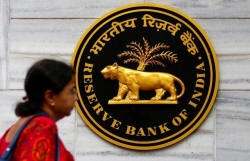Indian banks set to raise lending rates, pre-empting RBI
 Send a link to a friend
Send a link to a friend
 [February 08, 2018]
By Suvashree Choudhury and Devidutta Tripathy [February 08, 2018]
By Suvashree Choudhury and Devidutta Tripathy
NEW DELHI/MUMBAI (Reuters) - India's
struggling economy is facing a new challenge: banks are raising interest
rates even though the central bank is leaving its rates unchanged, as
risks such as surging bond yields and more provisioning requirements
erode their profit.
HDFC Bank <HDBK.NS>, India's second-biggest bank by assets, on Wednesday
became the latest to raise some rates by 10 basis points. The same day,
the Reserve Bank of India kept its policy rate unchanged, to "carefully"
nurture economic growth.
Other major banks are likely to follow suit, raising concerns of de
facto rate increases in an economy that is growing at its slowest pace
in three years and needs private investment.
An RBI staff study showed every 100 bps increase in borrowing costs
lowers the investment rate by as much as 91 bps.

"Lending rates will move up. We cannot avoid that from happening," the
chief of a large state-run bank told Reuters.
Banks are facing a number of threats. Chief among them is that rising
inflation has hurt bonds, driving benchmark 10-year yields <IN10YT=RR>
up more than 100 bps since July, a big concern for banks, which are the
biggest buyers of the debt.
Banks are also facing a higher cost of funds, a key expense for the
lenders, and more stringent regulatory requirements for their liquidity
coverage ratios, according to Ashish Parthasarthy, treasurer at HDFC
Bank.
[to top of second column] |

A woman walks past the Reserve Bank of India (RBI) head office in
Mumbai, India, December 6, 2017. REUTERS/Shailesh Andrade

Banks are also being forced to raise deposit rates so they can attract more
funds, and they continue to set aside more capital as they clear a near-record
$147 billion in soured debt.
Economists see little relief in sight, but are calling on the RBI to step in to
support debt markets, including through debt purchases, thus easing at least one
of the major challenges banks face.
In a measure of how much margins are being hit, the spread between the 10-year
bond yield and a key lending rate, the median one-year marginal cost-based
lending rate, has narrowed to only 80 bps from 200 bps in July.
"Lending rates might go up with such a large increase in bond yields," said
Soumya Kanti Ghosh, chief economist at State Bank of India.
"Under such circumstances, it is important to help cool off bond yields to
protect the overall interest rates from going up and hurting incipient signs of
growth."
($1 = 64.2800 Indian rupees)
(Reporting by Suvashree Choudhury and Devidutta Tripathy; Editing by Rafael Nam,
Larry King)
[© 2018 Thomson Reuters. All rights
reserved.] Copyright 2018 Reuters. All rights reserved. This material may not be published,
broadcast, rewritten or redistributed.
Thompson Reuters is solely responsible for this content.
 |